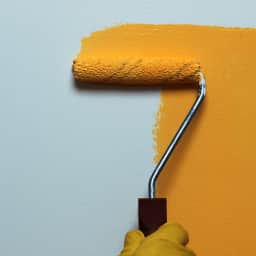
What Is Primer Paint – A Complete Guide!

By Urban Company
3 min read
Jan 05, 2024
Simply put, primer paint is the substance applied on walls and surfaces before you paint over them. This is also why primer paint is also known as an undercoat. ...

Simply put,
primer paintis the substance applied on walls and surfaces before you paint over them. This is also why primer paint is also known as an undercoat.
But do your walls and surfaces really need primer paint? What happens when you don’t use a primer? Read on to learn more about what is primer paint, its types, and its uses.
What is the difference between primer and paint?
As explained earlier, primer paint is a coating applied to any surface to prepare it for the topcoat or paint. It is designed to form a binding layer between the paint and the surface that is being painted. Essentially, primer paint is applied before the actual paint, while the shade of paint you choose for your walls is applied on top of the primer to give it a finished appearance.
What is primer paint used for?
Starting off with a coat of primer creates a smooth base for the paint, hides any existing imperfections, and makes the paint stick to the surface for a longer time. It is typically used on uneven materials that have been patched up or previously painted on. A coat of primer paint also enhances the durability of the paint on top and protects the walls from damage caused by environmental elements such as dust, dirt, etc.
What are the different types of primer paints available?
Various categories of primer paints are available today, and which one you choose largely depends on the surface you need to paint. The types of primer paints include water-based acrylic primer paint for protection against moisture and mildew, oil-based alkyd primer paint for rust protection, shellac primer paint for sealing pores and hiding stains, bonding primer paint for painting over surfaces like tiles or glass, corrosion-resistant metal primer paint for painting on metal surfaces, and masonry primer paint for porous surfaces like brick or concrete.

Is primer paint really necessary?
Adding coating before the paint is an extra step that involves more money and time. But to achieve the best finish and ensure that your walls look good for long, adding a coat of primer paint is highly recommended. To begin with, primer paint provides a surface for the paint to stick to, helps cover any imperfections or repair jobs on the wall, and seals any pores on the surface, making it even in the process. More importantly, the primer neutralises the darker shade when going from an existing darker colour to a lighter one, thereby giving your walls a blank canvas to paint on.
How many coats of primer paint should you use?
The number of coats of primer paint you need to apply depends on the condition of your walls. If the wall is in good condition and you are not drastically changing colours, one coat of primer should suffice. But, for the best results and best possible finish, two coats of primer paint are recommended. This ensures that the coating is durable, long-lasting and uniform.

Is primer more expensive than paint?
Primer paint is usually cheaper than wall paint, and using it also helps in saving costs. Since primer paint creates an ideal surface to paint on, you will require fewer coats of actual wall paint to achieve the desired look. Its longer shelf life also means you won’t have to spend money on touch-ups or repairs very soon.
What are the disadvantages of primer paint?
While the pros outweigh the cons, there’s one disadvantage associated with using primer paint. It increases the time taken to paint a wall or surface. After adding a coat of primer paint, you must wait for it to dry completely before you can start using the selected colour. This results in added time and labour costs.
An important thing to note is that, like any other paint, primer paint emits strong fumes that can be hazardous to health if someone is exposed to it for a long time. It is highly recommended that you work in a well-ventilated area using primer paint and wear gloves and masks to shield yourself from harmful effects.

Also, remember that every type of primer paint has different properties that determine its drying time. So, make sure you read the instructions before painting over the primer coat. Alternatively, you can get a trained professional to do the needful and get the best possible results for your walls and surfaces.
Our Services
Full home painting & waterproofing
4.80 (21.4K reviews)
Final painting cost to be paid, only after you are satisfied
Explore
Partial home painting & waterproofing
4.84 (10.4K reviews)
Consultation followed by quick & cost-effective painting service
Best for painting your rental property during move-in / move-out
Explore





